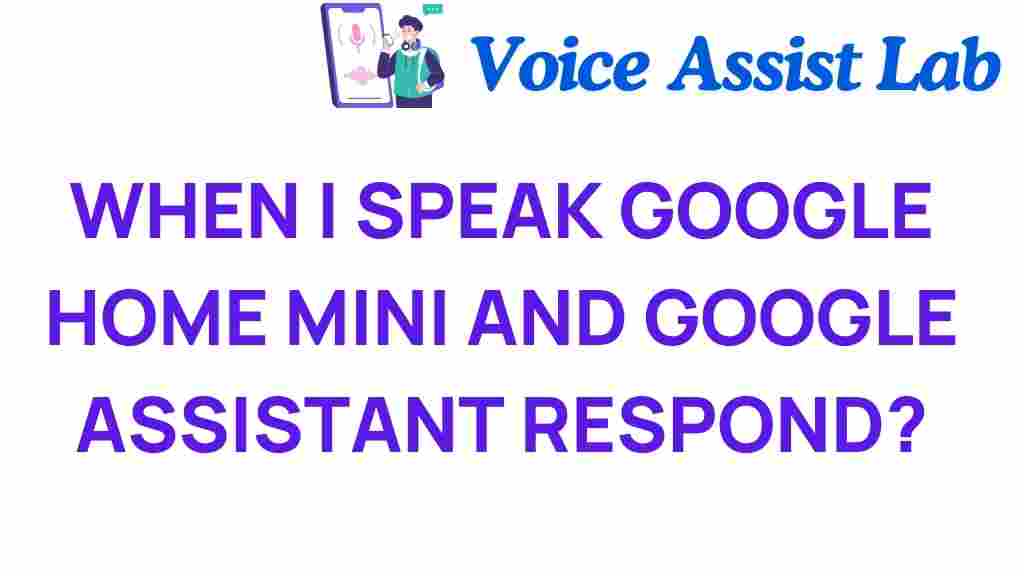The Intriguing World of Voice: How Google Home Mini Listens and Learns
In the age of digital transformation, voice technology has taken center stage, revolutionizing how we interact with our devices. Among the standout devices in this realm is the Google Home Mini, a compact smart speaker that utilizes advanced voice recognition technology to enhance user experience. This article delves into the fascinating world of voice technology, exploring how smart assistants like the Google Home Mini listen, learn, and integrate into our daily lives, while also examining technology trends that shape the future of home automation.
Understanding Voice Technology and Smart Assistants
Voice technology has evolved significantly over the past few years, leading to the rise of digital assistants that can perform a multitude of tasks through simple voice commands. The Google Home Mini exemplifies this innovation by incorporating AI interaction to create a seamless user experience. Here are some key features that define voice technology:
- Voice Recognition: The ability to identify and process human speech, allowing users to interact with devices naturally.
- AI Interaction: Leveraging artificial intelligence to understand context, intent, and nuances in conversation, making interactions more intuitive.
- Home Automation: Enabling users to control smart home devices, such as lights, thermostats, and security systems, using voice commands.
- User Experience: Focusing on creating a smooth and efficient interaction between humans and devices, ensuring accessibility and convenience.
How Google Home Mini Listens and Learns
The Google Home Mini is designed to be a conversational partner, continuously learning from its interactions with users. Here’s a step-by-step process on how it operates:
1. Activation and Listening
To initiate a command, users say the wake word, “Hey Google” or “OK Google.” This prompts the device to start actively listening for the user’s voice commands.
2. Voice Recognition
Once activated, the Google Home Mini employs sophisticated voice recognition algorithms to interpret the spoken words. This involves:
- Sound Processing: The device captures sound waves through its microphone array and converts them into digital data.
- Natural Language Processing (NLP): Using NLP, the assistant decodes the user’s intent behind the words, allowing it to respond appropriately.
3. AI Interaction and Learning
As users interact with the Google Home Mini, the device learns from these experiences:
- Personalization: The more a user interacts with the device, the better it understands individual preferences and speech patterns.
- Contextual Awareness: The assistant can remember previous interactions and use that context to improve future responses.
4. Home Automation Integration
The Google Home Mini seamlessly integrates with various smart home devices, enabling users to control their environment with voice commands:
- Smart Lights: Users can say, “Turn on the living room lights,” and the device will communicate with compatible smart bulbs.
- Thermostats: Adjusting home temperature is as simple as saying, “Set the thermostat to 72 degrees.”
- Security Systems: Users can arm their security systems or check camera feeds using voice commands.
Technology Trends Shaping Voice Technology
The landscape of voice technology is constantly evolving, driven by advancements in AI and user demand. Here are some notable trends:
- Enhanced Voice Recognition: Continuous improvements in voice recognition accuracy are making devices like the Google Home Mini more reliable.
- Multilingual Capabilities: With a growing global user base, smart assistants are increasingly able to understand and respond in multiple languages.
- Integration with IoT Devices: The proliferation of Internet of Things (IoT) devices is expanding the capabilities of voice technology in home automation.
- Focus on Privacy and Security: As voice assistants collect data, companies are prioritizing user privacy and implementing security measures to protect personal information.
User Experience and Voice Technology
A key factor in the adoption of voice technology is the user experience it delivers. The Google Home Mini strives to provide an intuitive and engaging experience through:
- Simplicity: Users can easily initiate commands without needing extensive technical knowledge.
- Accessibility: Voice technology offers hands-free control, making it a valuable tool for individuals with disabilities.
- Engagement: The conversational nature of voice assistants makes interactions feel more personal and interactive.
Troubleshooting Common Issues with Google Home Mini
Despite the sophisticated technology behind the Google Home Mini, users may encounter some common issues. Here are troubleshooting tips to resolve them:
1. Device Not Responding
If your Google Home Mini is unresponsive:
- Check the power connection and ensure it is plugged in securely.
- Restart the device by unplugging it and plugging it back in.
- Ensure the microphone is turned on; it may be muted.
2. Poor Voice Recognition
For issues with voice recognition:
- Make sure you are speaking clearly and directly towards the device.
- Reduce background noise, as it can interfere with the microphone.
- Recalibrate the device by training it to recognize your voice better in the Google Home app.
3. Connectivity Problems
If the Google Home Mini is having trouble connecting to Wi-Fi:
- Check your internet connection and ensure your router is functioning properly.
- Restart your router and try reconnecting the device through the Google Home app.
- Move the device closer to the router to improve connectivity.
Conclusion
The Google Home Mini stands at the forefront of the voice technology revolution, offering users a glimpse into the future of home automation and AI interaction. With its ability to listen, learn, and respond to voice commands, it enhances the user experience while integrating seamlessly with smart home devices. As technology trends continue to evolve, voice technology will undoubtedly play a pivotal role in shaping the way we interact with our digital assistants. For more information on the latest in voice technology, visit this resource.
Whether you are new to smart assistants or a seasoned user, understanding how the Google Home Mini functions can empower you to make the most out of your voice technology experience. Embrace the future of home automation and enjoy the convenience that comes with it!
This article is in the category Voice and created by VoiceAssistLab Team
